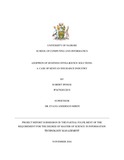| dc.description.abstract | The insurance sector in Kenya is riddled by many challenges among them low penetration levels, low persistency ratios and poor claims payment history. These problems have been persistent for a long time and they are mainly attributed to very low innovation levels across the sector. The low innovation level in the Kenyan insurance sector is mainly due to limited adoption of appropriate technological tools like Business Intelligence Solutions.
The objective of this project was to come up with an appropriate model for adoption of business intelligence (BI) solutions within the Kenyan insurance sector and to validate the proposed model for adoption of BI solutions within the Kenyan insurance sector.
Descriptive survey research type was used in this study. The population of the study consisted of all insurance companies duly licensed to transact in Kenya in the year 2016. Census sampling technique was. The primary data was collected using questionnaires with closed ended questions. The independent variables section of the questionnaire had five sub-sections namely; Users characteristics, Technological characteristics, Environmental characteristics, Organizational characteristics and Key decision maker characteristics. The questionnaires were administered in two ways; personal interview, and mail survey through drop and pick method. Descriptive statistics were used to analyze collected data. Confirmatory factor analysis was used to validate the proposed model.
The regression analysis results showed the relationships between user characteristics, organizational characteristics & key decision maker characteristics and adoption of BI were statistically significant. This is because their p-values were less than 0.05. On the other hand, the relationships between technological characteristics & environmental characteristics and adoption of BI were statistically insignificant since their p-values were greater than 0.05. The findings further revealed that key decision maker characteristics and organizational resources had a significant relationship with likelihood of adoption BI. This is because their p-values were less than 0.05. However, user characteristics, technological characteristics and environmental characteristics were found to have insignificant relationship with likelihood of adoption of BI solutions. These variables had p-values above 0.05.
The study recommended the validated model for adoption of BI solutions to the Kenyan insurance industry IT practitioners to use it as the basis for adoption BI and related technologies. | en_US |



